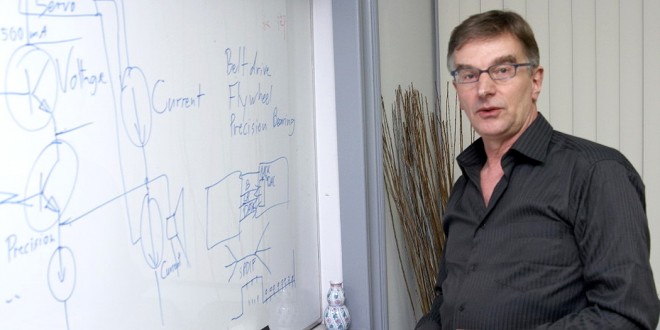First let’s have a look at a traditional setup with B.M.C. components:
先來看看B.M.C傳統的設置方法
This looks pretty “business as usual“: There is a DAC with integrated Preamp and a volume control, connected to a power amplifier. If you turn the volume knob, the signal is attenuated by a potentiometer, and the power amplifier has the usual fixed gain. In this combination you can exchange AMP S1 or M1 to a different power amplifier, or as well exchange DAC1PRE to a different DAC and a preamp – still working. This kind of setup should be familiar for every HiFi user.
這個圖與一般系統的連接情況差不多,就是有音量前級的DAC然後連接到後級,如果轉音量,那訊號就會隨電位計調整,後級的增益是固定的,在這樣的組合下,您可以將AMP S1或M1換成不一樣的後級,或是將DAC1PRE換成不同的DAC與前級。
But: Let us have a look at the copy stages: First there is the DAC section with the D/A-converter, a CI-I/V-converter (no copy) and the LEF buffer (one copy). This signal is attenuated by the potentiometer and buffered by the LEF output stage (one copy). The output signal goes to the XLR input of the AMP S1/M1, amplified (one copy) with a fixed gain to the output voltage, and finally the LEF buffer (one copy) adds the required current for driving the speakers. That’s a total of four copies. Or: At the output you get the fifth generation of the input signal.
不過我們來看COPY的部份,首先DAC有D/A轉換、CI-I/V轉換(No Copy)與LEF緩衝(one copy),訊號隨電位計調整,且由LEF輸出級(one copy)所緩衝。輸出訊號到AMP S1/M1的XLR輸入,以固定的增益放大(one copy)到輸出的電壓,也就是輸出是輸入的第5代的訊號了。
Still not bad if compared to most designs, needing five to ten copies in the DAC, another five to ten copies in the preamp and another at least four copies in the power amplifier (differential stage, voltage gain – needed for feedback loop, driver stage plus output stage), a total of fourteen to over twenty copies. Or: You listen to the fifteenth (or more) generation.
與大部份DAC的設計相比,需要5~10次COPY已經好多了,前級一般要5~10次COPY,後級要至少4次的COPY (動差級、電壓增益、迴授、驅動級與輸出級),一共有14~20次的COPY,您聽到的是第15代或更多Gereration的訊號。
But we can do even shorter (= better). Let’s have a look at the short signal path our B.M.C. chain is intended for:
但我們可以讓這個更短 (=更好),讓我們看看B.M.C最短的路徑
In this setup the preamp section of DAC1PRE is configured by an internal jumper setting to loop-through mode, means the signal of the DAC section (as well as the analogue XLR input) is just routed to the output. (The unbalanced RCA input needs an extra stage to get a balanced signal.) For all digital inputs it means: The music signal is same as at the fixed output of the DAC section. Volume control doesn’t do anything to the music signal inside of DAC1PRE. This means: The unattenuated signal is connected to the XLR-CI input of the AMP S1 or M1. The volume control of the DAC1PRE just generates a digital word, transmitted by an optical waveguide to AMP S1 or M1, where the gain is adjusted (DIGM) according to the digital word. And for the user’s information we display the DIGM setting in the window.
在這樣的設置下,DAC1PRE前級部份從內部的跳線設定為loop-through模式,意味著DAC的訊號(XLR類比輸入也是)是傳到輸出。(非平衡輸入確實需要額外的輸入來得到平衡的訊號)。對所有的數位輸入意味著:音樂訊號在DAC固定輸出是一樣的,在DAC1PRE音量對音樂訊號並沒有做了什麼,這意味著,訊號連到AMP S1或M1的XLR-CI輸入時並未改變(no copy),在DAC1PRE的音量只有產生數位語言,將光學波導傳到AMP S1或M1,在這其增益是依數位語言來調整的(DIGM),我們在後級的表頭會顯示DIGM的設定。
Once set up this way, there is no handling difference compared to the traditional connection.Let’s have a look at the copy stages again: First there is the DAC section with the D/A-converter, a CI-I/V-converter (no
copy) and the LEF buffer (one copy), available at the output of the DAC module, and this signal is routed to the preamp output as well. The output signal is connected to the XLR-CI input (no copy) of the AMP S1/M1, amplified with adjustable gain (DIGM) to the output voltage, and finally the LEF buffer (one copy) adds the required current for driving the speakers. That’s a total of only two copies! Or: At the output you get the third generation of the input signal.
我們近一步看COPY的部份,首先在DAC有D/A、CI-I/V-converter (no copy)、LEF buffer (one copy),輸出訊號連到AMP S1/M1的XLR-CI (no
copy),使用DIGM調整增益到輸出電壓,最後LEF buffer (one copy)增加驅動喇叭所需的電流。
The above explanation is about digital sources.
以上是對數位部份的解釋。
Let’s have a look at a B.M.C. chain with the PHONO MCCI involved: PHONO MCCI has a CI input (no copy), a second gain stage (one copy) and an output LEF buffer (one copy). In a traditional setup with B.M.C. components this means: PHONO MCCI: two copies, Preamp of DAC1PRE: one Copy, AMP S1 or M1: two copies. A total of five copies (means listening to the sixth generation) – still not bad for the tiny signal of a moving coil pickup amplified to drive speakers.
若是PHONO MCCI有CI輸入(no copy)、第2個增益級 (one copy)與 output LEF buffer (one copy)。在B.M.C傳統的設置下意味著,PHONO MCCI:有兩個COPY,DAC1PRE的前級 (one copy)、AMP S1或M1(two copies),總共有5個copies (意味第6代訊號),依然對微小訊號去擴大驅動喇叭不是太差。
The B.M.C. shortcut with DIGM means: PHONO MCCI: two copies, DAC1PRE: No copy because of Loop-Through, DAC1PRE volume control
sets the DIGM inside of the power amp, AMP S1 or M1: No copy at CI input, one copy in the final LEF stage. That’s a total of just three copies (means listening to the fourth generation) from PHONO MC to the speakers!
B.M.C的DIGM則是捷徑: PHONO MCCI: two copies、DAC1PRE:無,沒有COPY是因為Loop-through、DAC1PRE音量控制設定了在擴大機裡的DIGM,AMP S1或M1:在CI 輸入這段是沒有COPY的,有一個COPY是在最後的LEF級發生,總共就只有3次COPY。 (也就是從Phono到喇叭是聽到第4代訊號)
That’s the general description of how we look at the signal path, and why we like to keep it short. What counts in the end is the listening experience of the music reproduction. Sure, even one of our units in an existing HiFi setup may provide some new listening experience. But may be you got the idea: If you use one of our units, making only two copies (or two more
generations), in a chain with already ten copies (or ten generations), it may make a difference, but it is far from how we intend music to be experienced. If you like to get an idea about how we like music to be reproduced, try our “shortcut“ B.M.C. chain, using the CI input.
這是我們對訊號路徑的基本解釋,為什麼我們喜歡讓他越短越好,最後就是反應在音樂的再生。當然,任何一台B.M.C的器材都能有一些新的聆聽體驗,但當您使用一台我們的器材 (只有2個COPY) 到1個已有10個COPY的系統中,雖然會不一樣,但跟我們想要表達的音樂再生體驗有落差,如果您要體驗B.M.C的器材聲音,那就是使用CI輸入。
